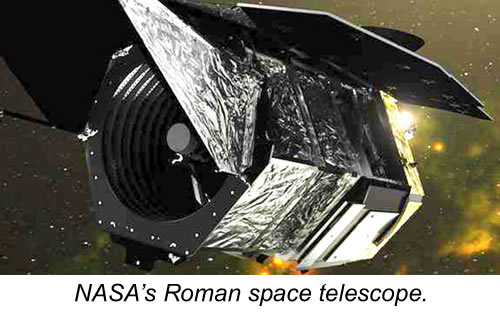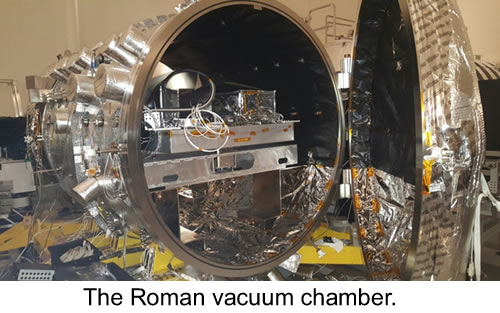
U.S. Tech – November 2022
Test and Measurement
Space Telescope Vibration Isolation Optimizes Image Clarity
By Steve Varma
The Nancy Grace Roman Space Telescope (Roman), formerly named the Wide Field Infrared Survey Telescope (WFIRST), is a NASA space observatory currently in development and is scheduled to launch into space no later than May 2027.
The Roman Space Telescope hosts two instruments: the Wide Field Instrument (WFI) which emphasizes studying the evolution of the universe and understanding what solar systems beyond our own are like; and the Coronagraph Instrument to advance technologies for extreme high contrast imaging and spectroscopy from space.
In 1998, scientists discovered that the expansion of the universe is accelerating, causing them to reconsider their models for the formation of the universe. Visible matter accounts for only about five percent of the contents of the universe.
Nearly 27 percent of the universe comes in the form of dark matter, which doesn’t emit or absorb light.
NASA’s Roman space telescope. Dark matter is only detectable through its gravitational effects on visible matter.
A significant portion of the Roman’s mission will be dedicated to monitoring hundreds of thousands of distant galaxies for supernova explosions, which can be used to study dark energy and the expansion of the universe.
Roman’s primary instrument is the Wide Field Instrument (WFI) which will have a field of view that is 100 times greater than Hubble’s widest exposure. It will capture more of the sky with less observing time. Over the first five years of observations, Roman will image over 50 times as much sky as Hubble has covered so far in 30 years. The WFI will measure light from a billion galaxies over the course of the mission lifetime.
Shading Starlight
Discovering Earth-like planets with atmospheres may come down to the ability of blocking starlight from a telescope. Although this sounds like a tall order, this has been done since 1931 since when French astronomer Bernard Lyot introduced the first coronagraph. A coronagraph is an attachment to a telescope designed to block out the direct light from a star so that nearby objects, which otherwise would be hidden in the star’s bright glare, can be seen.

The Roman Space Telescope includes a Coronagraph Instrument that is a multi-layered and highly complex piece of technology, consisting of a system of masks, prisms, detectors, and two self-flexing mirrors (deformable mirrors). These mirrors are active components, changing their shape in real time to accommodate incoming light to compensate for tiny changes in the telescope’s optics and observatory vibrations.
In tandem with high-tech “masks” and other components — collectively known as “active wavefront control” — these mirrors remove the interference caused by light waves that bend around the edges of the coronagraph’s light-blocking elements. The end result is that starlight is greatly dimmed while faintly glowing objects (that were previously invisible) will appear relatively undimmed.
Testing Critical Components
The High-Contrast Imaging Testbed (HCIT) facility at NASA’s JPL is a large optical laboratory that hosts three optical testbeds inside vacuum chambers designed to advance coronagraph technologies for space.
The Roman testbed is a 6 foot diameter vacuum chamber with a 7.5-foot cylindrical section, and can accommodate tables up to 8 feet in length when accounting for the outward bulge of the end cap doors. Power cables, data cables, water lines, and optical fibers are fed through ports in the sidewalls. Two ports are occupied by camera umbilicals to connect bench-mounted camera enclosures to the lab air, which permit the use of Andor Neos CMOS cameras as science detectors in the chamber, despite their lack of vacuum compatibility.
These legs have a manual adjustment range that allows them to be returned to account for changes in weight distribution on the table following hardware modifications.
The testbed is heavily instrumented with temperature sensors, as well as a few accelerometers, with contamination monitors planned for the future. The chamber wall temperature is maintained to within ±0.1 K using a simple control system. More sophisticated control is used to stabilize the Deformable Mirror (DM) temperature to milli-K levels.
Within Roman, the bench and optical telescope assembly (OTA) sub-bench are on independent PI thermal control loops which stabilize the mean bench temperature to 30 mK P-V under normal conditions. The chamber itself is controlled to a set point above laboratory ambient by a PID loop implemented with heater tape insulation layer, and can be stabilized to 50 mK P-V. All optical mounts were machined from invar with optics bonds within flexure mounts, to minimize the effect of residual thermal fluctuations on the system. The primary heat sources on the table are the two cameras and the DM electronics, and all are cooled by a pair of external water-cooling loops.

A telescope simulator on a subbench is kinematically mounted to the northwest corner of the bench, and simulates the front end of the telescope. This includes a jitter mirror (JM) to inject tip/tilt errors into the coronagraph in a controlled manner, and a simulator for the optical telescope assembly which defines the upstream pupil and provides light that isn’t collimated as well.
The Decadal Survey Testbed (DST) is a new, advanced testbed aimed to demonstrate the coronagraph technologies required for a mission following Roman that will directly image and characterize Earth-like exoplanets, that consists of a stellar source simulator, two deformable mirrors (DMs) for wavefront control, coronagraph masks, a wavefront sensor, and an imaging camera. The DST’s optomechanical design minimizes disturbances from the laboratory and local environment.
At its foundation, the DST consists of a carbon-fiber optical table that is highly stable to thermal fluctuations. It also includes active temperature control, and Minus K’s SM-1CV Negative-Stiffness Vibration isolators customized for use inside the vacuum chamber to reduce the sensitivity to micro seismic and laboratory vibrations.
Testing Critical Components
The Roman Space Telescope will monitor hundreds of millions of stars every 15 minutes for months at a time — something no other space telescope can do. It will detect hundreds of interesting cosmic objects including dwarf planets, rogue planets, brown dwarfs (too massive to be characterized as planets but not quite massive enough to ignite as stars), comets, asteroids and stellar corpses, including neutron stars and black holes, which are left behind when stars exhaust their fuel within our solar system.
Contact: Minus K Technology, Inc., 460 Hindry Avenue, Unit C, Inglewood, CA 90301, 310-348-9656 E-mail: request@minusk.com Web: www.minusk.com
|